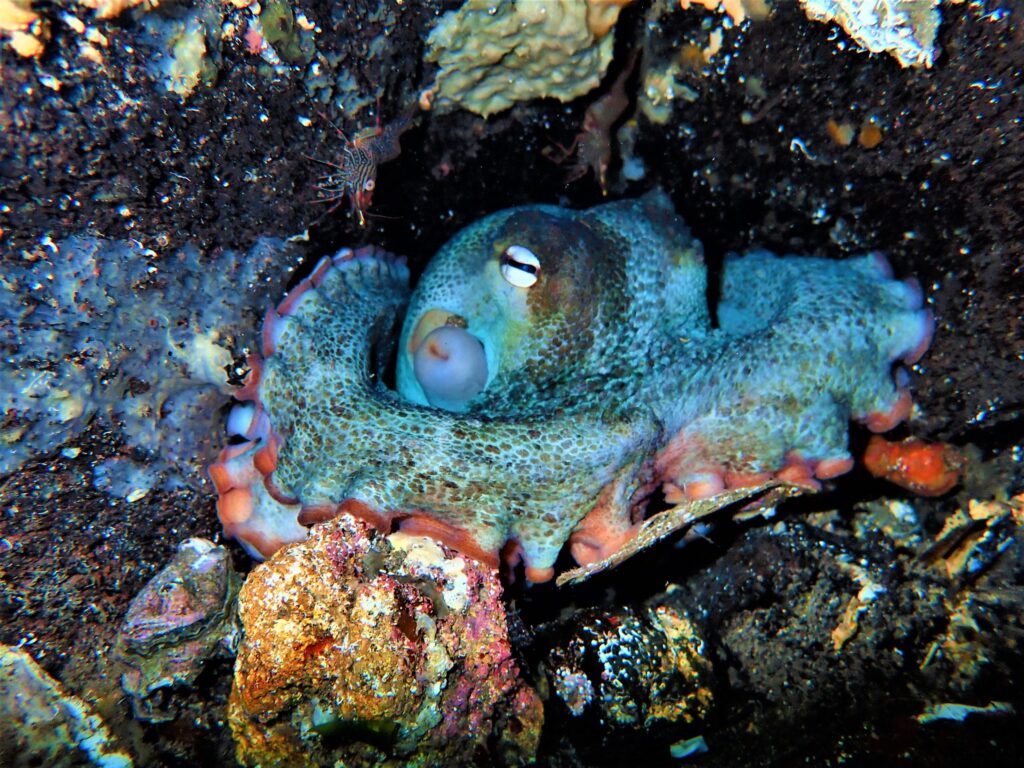Gloomy Octopus
Octopus tetricus
The gloomy octopus is an invertebrate in the class Mollusca, which also includes snails, clams and squid, however unlike their close relatives are shell-less. Octopuses are cephalopod molluscs which are generally considered to be the most inquisitive and intelligent marine invertebrates. Their high level of intelligence can be attributed to the hundreds of millions of years of evolution, where they have evolved a combination of behaviours used to address new situations. Maze and problem-solving experiments have proved octopuses to have excellent long and short-term memory, are capable of learning geography and have mastered deceit by means of mimicry. They also have the largest brain of any invertebrate in comparison to its body weight, a comparable similarity to that of mammals.
The gloomy octopus has a mottled brown and grey colouration with a rusty red colour lining the inside of each arm. They have a rounded body and head with characteristic eight arms that taper to a tip. The arms are uneven in length and each has two rows of suckers which are equipped with chemoreceptors, enabling the octopus to taste what it is touching. The gloomy octopus is one of the largest local octopus species, with an arm span of up to two metres. The octopus has three hearts, two of which pump copper-rich blood through each of the two gills, the third pumps the blood through the body. Similarly to cuttlefish, the gloomy octopus is able to rapidly change colour, display patterns and alter skin sculpture to impersonate seaweed while hunting, to merge into the background to avoid predation and to lure a potential mate for reproduction. Their colour and pattern changes are facilitated by the contraction of specialised skin cells; chromatophores contain the yellow, orange, red, brown and black pigment, iridophores give the reflective iridescence in green and blue hues and leucophores create the white patterning.
The male has a specialised arm which is used to transfer a packet of spermatophore into the female’s mantle cavity. Once fertilised, the female lays thousands of eggs in hanging chains from the ceiling of her lair. She does not feed during this time which may span up to a month, instead she takes care of her eggs by blowing water over them to reduce algal growth and guards them from predators. The gloomy octopus has a short life expectancy living to only three years of age, as reproduction is a cause of death. Males live for only a few months after mating, while females die shortly after the eggs have hatched. Once hatched, the larvae go through a planktonic stage before settling on the substratum. They can be commonly found in amongst rubble in sponge gardens, in seagrass beds of coastal estuaries and on rocky coastal reefs where they can be found hiding in their lair. The lair of the species can be easily identified by the bivalve shells that are scattered around its entrance.
The primary diet of the gloomy octopus is crustaceans and shellfish, they are opportunistic ambush predators and will feed on small fish if given the chance. The octopus use their radula, a rasping tongue, to drill a hole through the shell of the mollusc and inject a paralysing venom, allowing the octopus to pry open the shell and consume the contents. They have strong jaws shaped like a parrots beak to tear pieces off their prey. Octopus have several methods of locomotion, crawling along the seabed, or propelling themselves through the water via jet propulsion. If threatened, the octopus can eject a cloud of black ink to act as a screen while it escapes. Predators of the octopus are dolphins, whales, sharks, eels and fur seals. The gloomy octopus occurs commonly in south western Australia from Shark Bay to Esperance and on the east coast of Australia from Eden, NSW to Moreton Bay, Qld.
Other common names include: Sydney octopus
Occurrence at the Busselton Jetty:
The gloomy octopus is commonly observed from the underwater observatory. Masters of disguise and stealth they tend to be observed as they move from one place to another. We have seen colour changes as they pass over different substrates, active feeding on small fish and red bait crabs amongst the jetty piles and even confrontation with another gloomy octopus. Small individuals through to mature adults have been observed from the observatory.
Image by: S. Teede
